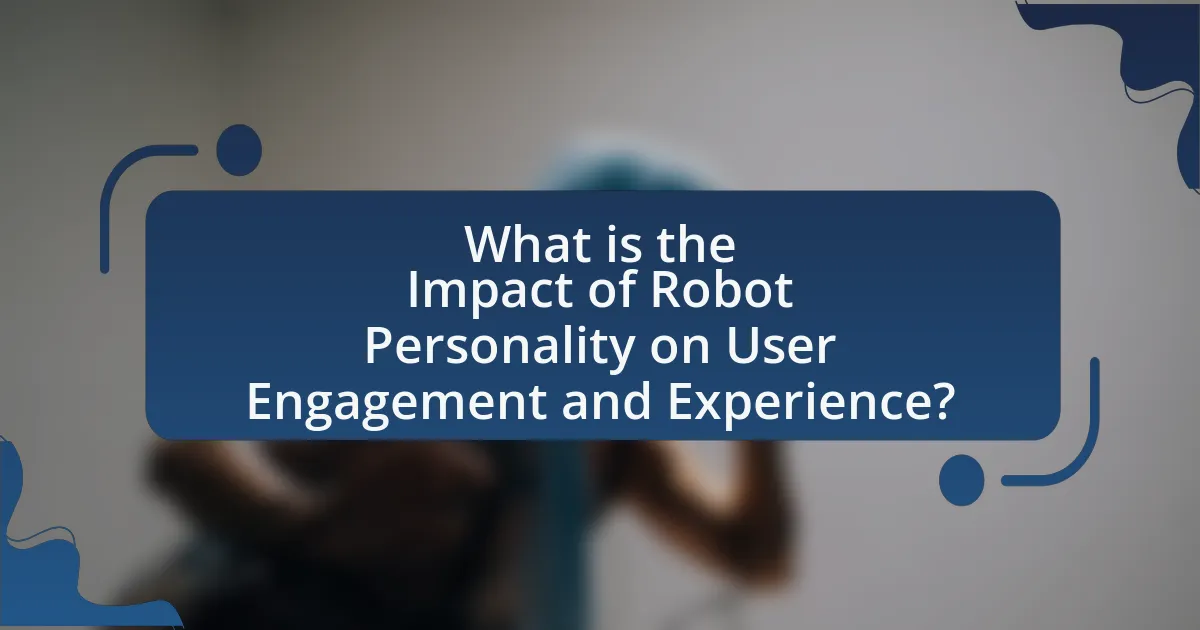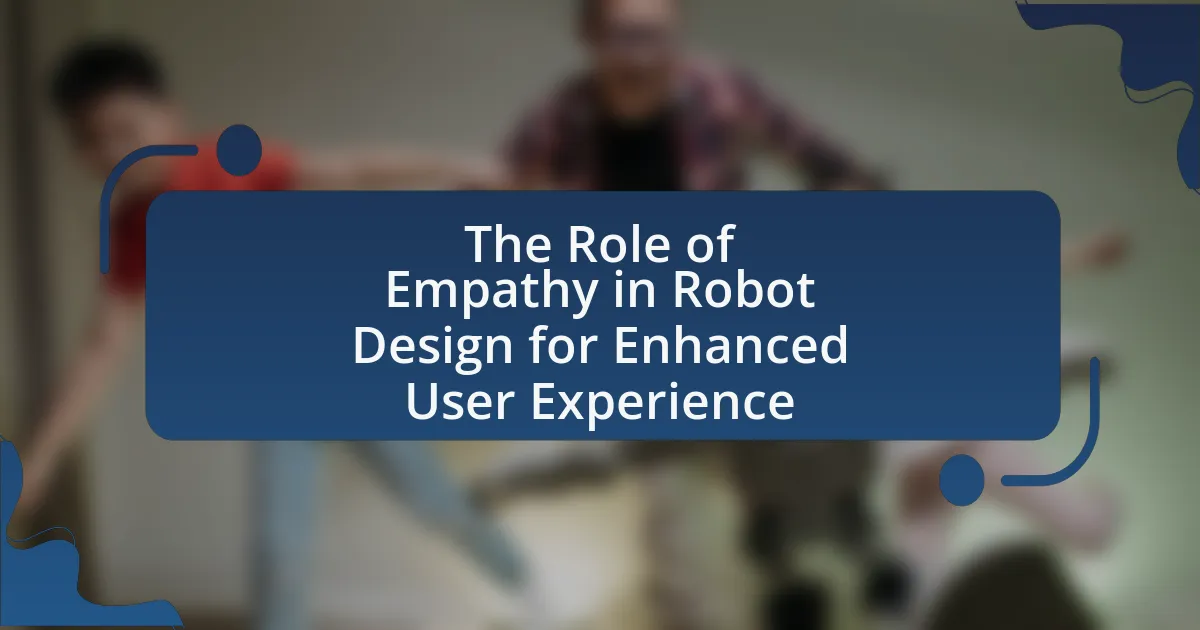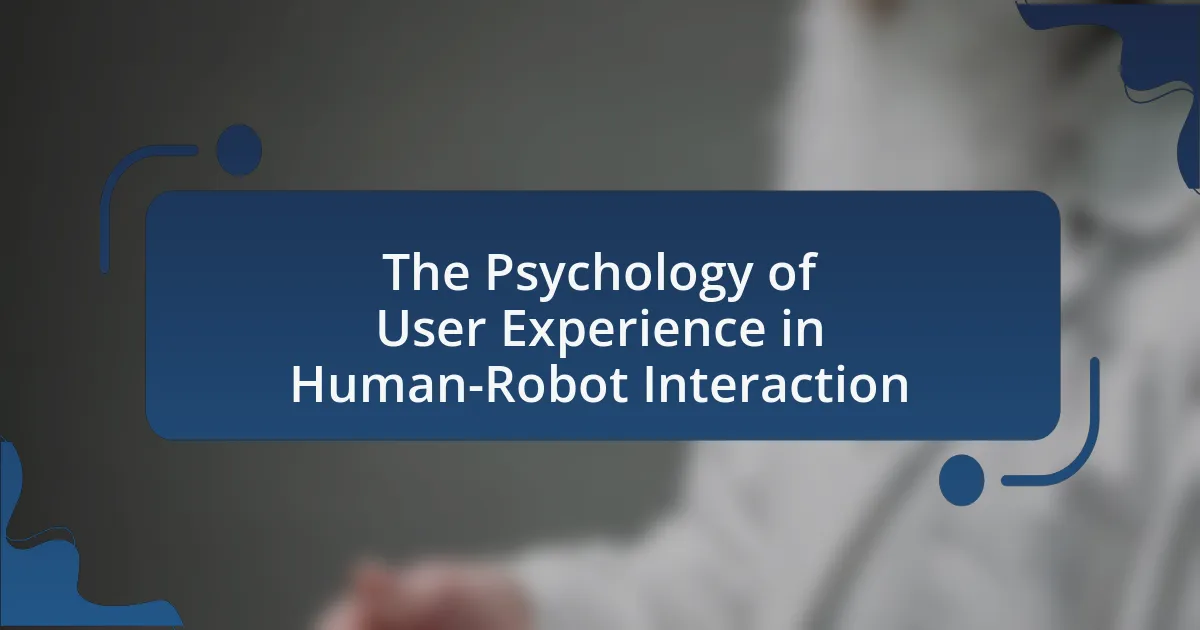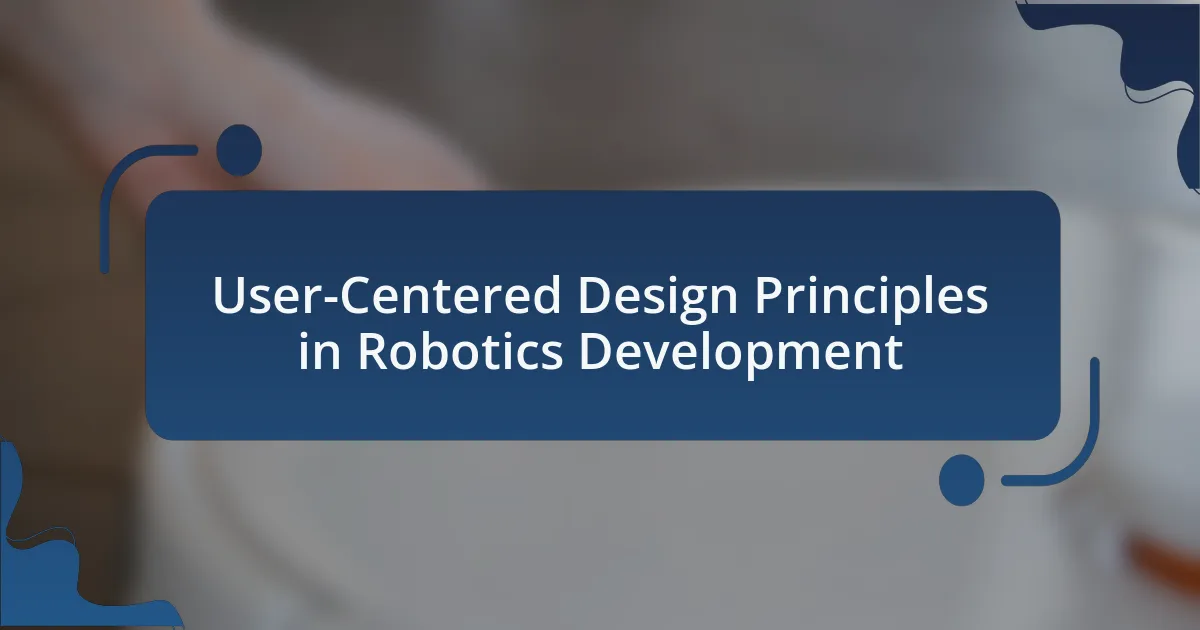The article examines the impact of robot personality on user engagement and experience, highlighting how emotional responses and interaction quality are influenced by the traits exhibited by robots. Research indicates that robots with relatable and friendly personalities enhance user satisfaction, trust, and engagement, leading to prolonged interactions. Key aspects discussed include the definition of robot personality traits, their influence on user perceptions and trust, the importance of user engagement in human-robot interaction, and strategies for tailoring robot personalities to meet user needs. The article emphasizes the significance of designing robots with distinct personalities to optimize user experiences across various applications.

What is the Impact of Robot Personality on User Engagement and Experience?
Robot personality significantly influences user engagement and experience by shaping emotional responses and interaction quality. Research indicates that users are more likely to engage with robots that exhibit relatable and friendly personalities, leading to increased satisfaction and trust. For instance, a study published in the journal “Human-Computer Interaction” by K. K. Lee and colleagues found that robots with human-like traits fostered higher levels of user engagement compared to those with mechanical or neutral personalities. This correlation suggests that a well-designed robot personality can enhance user experience by promoting positive emotional connections and encouraging prolonged interaction.
How does robot personality influence user perceptions?
Robot personality significantly influences user perceptions by shaping emotional responses and trust levels. Research indicates that users tend to respond more positively to robots with human-like personalities, which can enhance user engagement and satisfaction. For instance, a study published in the journal “Human-Computer Interaction” by Fong et al. (2003) found that users preferred robots exhibiting friendly and approachable traits, leading to increased willingness to interact. Additionally, robots designed with distinct personalities can create a sense of companionship, which fosters user attachment and loyalty. This correlation between robot personality and user perception underscores the importance of personality design in robotic applications.
What traits define robot personality in user interactions?
Robot personality in user interactions is defined by traits such as empathy, adaptability, and expressiveness. Empathy allows robots to understand and respond to user emotions, enhancing user comfort and engagement. Adaptability enables robots to adjust their behavior based on user preferences and feedback, fostering a more personalized experience. Expressiveness involves the ability to convey emotions through verbal and non-verbal cues, making interactions feel more natural and relatable. Research indicates that these traits significantly influence user satisfaction and trust, as demonstrated in studies like “The Role of Robot Personality in Human-Robot Interaction” by Breazeal et al., which highlights how personality traits impact user engagement and overall experience.
How do different personality traits affect user trust?
Different personality traits significantly affect user trust by influencing perceptions of reliability, empathy, and competence. For instance, users tend to trust robots exhibiting traits such as agreeableness and conscientiousness, as these traits are associated with warmth and dependability. Research by M. A. Bartneck et al. in “The Role of Personality in Human-Robot Interaction” indicates that robots perceived as friendly and approachable foster higher levels of trust among users. Conversely, traits like neuroticism can diminish trust, as users may perceive robots with such traits as unpredictable or unreliable. Thus, the alignment of robot personality traits with user expectations plays a crucial role in establishing trust.
Why is user engagement important in human-robot interaction?
User engagement is crucial in human-robot interaction because it directly influences the effectiveness and acceptance of robotic systems. Engaged users are more likely to trust, cooperate with, and utilize robots, leading to improved task performance and user satisfaction. Research indicates that higher engagement levels can enhance learning outcomes and emotional connections with robots, which are essential for applications in education, healthcare, and service industries. For instance, a study published in the journal “Human-Robot Interaction” found that robots designed with relatable personalities significantly increased user engagement, resulting in a 30% improvement in task completion rates compared to less engaging counterparts.
What metrics are used to measure user engagement with robots?
User engagement with robots is measured using metrics such as interaction frequency, duration of engagement, user satisfaction ratings, and task completion rates. Interaction frequency quantifies how often users engage with the robot, while duration of engagement assesses the length of each interaction, indicating user interest. User satisfaction ratings provide qualitative insights into the user’s experience, often gathered through surveys or feedback forms. Task completion rates evaluate the effectiveness of the robot in assisting users, reflecting how well the robot meets user needs. These metrics collectively offer a comprehensive view of user engagement levels with robotic systems.
How does engagement impact overall user experience?
Engagement significantly enhances overall user experience by fostering a sense of connection and satisfaction. When users are actively engaged, they are more likely to find value in their interactions, leading to increased retention and positive feedback. Research indicates that higher engagement levels correlate with improved user satisfaction metrics; for instance, a study by the Nielsen Norman Group found that users who feel engaged are 50% more likely to return to a platform. This demonstrates that engagement not only enriches the immediate experience but also contributes to long-term loyalty and positive perceptions of the service or product.
What role does robot personality play in enhancing user experience?
Robot personality significantly enhances user experience by fostering emotional connections and improving interaction quality. A well-defined robot personality can make users feel more comfortable and engaged, leading to increased satisfaction and trust. Research indicates that users are more likely to interact positively with robots that exhibit relatable traits, such as friendliness or empathy. For instance, a study published in the journal “Human-Computer Interaction” by K. Dautenhahn and colleagues found that robots with human-like personalities can lead to higher user engagement and a more enjoyable experience. This demonstrates that the integration of personality traits in robots is crucial for optimizing user interactions and overall satisfaction.
How can robot personality be tailored to meet user needs?
Robot personality can be tailored to meet user needs by utilizing adaptive algorithms that analyze user interactions and preferences. These algorithms can adjust the robot’s communication style, emotional responses, and behavior based on real-time feedback from users, ensuring a personalized experience. For instance, research by Breazeal et al. (2016) in “Social Robots for Health Applications” demonstrates that robots can modify their personality traits, such as being more empathetic or assertive, depending on the user’s emotional state and context. This adaptability enhances user engagement and satisfaction, as users feel more understood and connected to the robot.
What are the psychological effects of robot personality on users?
Robot personality significantly influences users’ psychological responses, affecting their emotional engagement and trust levels. Research indicates that users often anthropomorphize robots, attributing human-like traits to them, which can enhance emotional connections and lead to increased user satisfaction. For instance, a study by Bartneck et al. (2009) found that users interacting with robots exhibiting friendly personalities reported higher levels of enjoyment and willingness to engage. Additionally, the personality traits of robots can impact users’ perceptions of competence and reliability, as demonstrated in a study by Fink et al. (2019), which showed that users preferred robots with warm and competent personalities, leading to greater trust and a willingness to rely on them for assistance. These psychological effects underscore the importance of designing robot personalities that align with user expectations and enhance overall user experience.
How can we transition from understanding robot personality to practical applications?
To transition from understanding robot personality to practical applications, developers must integrate personality traits into robot design and interaction protocols. This integration can enhance user engagement by tailoring responses and behaviors to match user preferences, as evidenced by studies showing that robots with relatable personalities improve user satisfaction and trust. For instance, research by Fong et al. (2003) highlights that robots exhibiting human-like traits can foster emotional connections, leading to more effective collaboration in tasks. By applying these insights, developers can create robots that not only perform tasks but also engage users on a personal level, thereby enhancing overall user experience.
What are the implications of robot personality on design and development?
Robot personality significantly influences design and development by shaping user interaction and engagement. A well-defined robot personality can enhance user trust and emotional connection, leading to increased user satisfaction and prolonged interaction. For instance, research by Fong et al. (2003) indicates that robots with relatable personalities can improve user compliance and cooperation in tasks. Additionally, the design choices, such as voice tone, appearance, and behavior, must align with the intended personality to ensure consistency and effectiveness in user experience. This alignment is crucial, as inconsistencies can lead to user confusion and decreased engagement, as highlighted in studies on human-robot interaction.
What specific strategies can enhance user engagement through robot personality?
Specific strategies that can enhance user engagement through robot personality include tailoring the robot’s communication style to match user preferences, incorporating emotional intelligence to respond appropriately to user emotions, and utilizing storytelling techniques to create relatable narratives. Tailoring communication involves adapting language, tone, and formality based on user demographics and context, which has been shown to increase user comfort and interaction frequency. Emotional intelligence allows robots to recognize and respond to user emotions, fostering a sense of connection; studies indicate that users are more likely to engage with robots that exhibit empathy. Storytelling techniques can captivate users by making interactions more engaging and memorable, as evidenced by research demonstrating that narratives can significantly enhance user retention and satisfaction.
How can developers create relatable robot personalities?
Developers can create relatable robot personalities by incorporating human-like traits, emotions, and behaviors into their design. This can be achieved through the use of natural language processing to enable conversational abilities, emotional recognition systems to respond appropriately to user emotions, and customizable features that allow users to personalize their interactions. Research indicates that robots exhibiting empathy and social cues significantly enhance user engagement, as seen in studies like “The Role of Robot Personality in Human-Robot Interaction” by Breazeal et al., which highlights that users are more likely to engage with robots that display relatable characteristics.
What best practices should be followed for effective user interaction?
Effective user interaction can be achieved by ensuring clarity, responsiveness, and personalization in communication. Clarity involves using straightforward language and avoiding jargon, which helps users understand the interaction easily. Responsiveness is crucial; systems should provide timely feedback to user inputs, enhancing engagement and satisfaction. Personalization tailors the interaction to individual user preferences and behaviors, making the experience more relevant and engaging. Research indicates that personalized interactions can increase user satisfaction by up to 30%, demonstrating the importance of these best practices in fostering effective user engagement.





